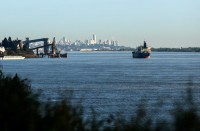From Cairo to Luxor, Egyptologists are working alongside physicists and engineers to try to solve the secrets of the pharaohs.
Using non-invasive exploration techniques which won’t damage the monuments, teams of researchers began scanning Egypt’s pyramids in October 2015.
They are focusing on the Bent and Red pyramids at Dahshur, together with Khufu – also known as the Great Pyramid – and Khafre, built on the Giza plateau 4,500 years ago.
Using infrared thermography, researchers hope shed light on how exactly the pyramids were built, and search for hidden rooms and corridors.
This technique can measure heat absorbed or emitted by a body and create a thermal map of sites.
Red marks hot zones, exposed to the sun. In blue, the cold spots, which could signal a draft where air is getting in, such as a corridor or secret chambers. Thermal anomalies indicating differences of up to six degrees have been detected on the Khufu pyramid.
Researchers can also radiograph the pyramids using cosmic particles known as muons, heavy particles which rain down on earth at the speed of light.
By strategically placing sensors, any voids which allow the particles to penetrate can be detected, as well as dense zones which deflect or absorb particles.
Scientists use chemical emulsions, delicate films which need to be developed in a laboratory or electric scintillators which produce an image with greater contrasts in real time. Telescopes using muon radiography have detected hidden cavities in the Great Pyramid of Giza.
In the Valley of the Kings, it’s Tutankhamun’s tomb which fascinates. Discovered in 1922 with its treasure still intact after 3,000 years, it could also contain two hidden chambers and possibly even the mummy of Queen Nefertiti, according to Egyptologist Nicolas Reeves.
After initial infrared scans indicated the presence of cavities and possible organic material, several teams carried out further tests on the tomb walls in 2015 and 2016.
But uncertainty over the findings means that more thorough analysis is needed before any invasive exploration can be carried out.
Credit: DAVID LORY, KATHERINE LEVY SPENCER / AFP VIDEOGRAPHICS / AFP








